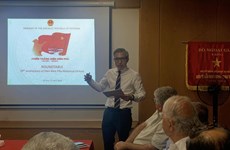Vietnam to allow online immigration
The Border Guard Command under the Ministry of Defence will implement e-immigration at all sea ports across the country by 2018, said Vice Head of the Border Guard Management Department Le Anh Tuan.
The department has launched a pilot programme on e-imigration at seven seaports in Hon Gai, Hai Phong in the north, Da Nang, Quy Nhon, Nha Trang in the central, HCM City and Ba Ria-Vung Tau in the south, the official said to Hai Quan (Customs) newspaper.
The move helped cut the number of immigration procedures from nine to five and time to process a vessel to less than one hour, Tuan said.
Applicants did not need to travel to seaport border gates to submit their finished application forms verified by marine port authority.
"Using the e-procedures helps save time, which helps vessel owners save costs on traveling and anchoring," he said.
It also helped speed up goods loading/unloading at sea ports.
"Up to 80 percent of firms using the seaports have registered for the online programme," Tuan said.
He also said that now it took only 20-30 seconds to finish immigration procedures for one person.
The Border Guard Department is in charge of order and security at 105 ports in 30 seaport border gate areas in 24 provinces and cities nationwide.
About 6 million foreign visitors and 600,000 vessels arrive in Vietnam via seaports each year.
The vice head of the department said that e-border procedures were part of its efforts in administrative simplification.
They were making great use of information and technology, Tuan said.
For example, they set up data processing centres at 21 international border gates, 29 high speed data transmission lines and over 3,000 devices including passport readers, card readers and radioactive detectors.
He said that the Border Guard Command was working with Vietnam Customs to connect its e-border system with the portal Vietnam National Single Window (NSW).
Since its introduction in May, the NSW has significantly reduced time required for customs clearance.
The NSW established connections with the ASEAN Single Window early last month, a platform to co-ordinate customs administrations for the formation of the ASEAN Economic Community at the end of the year.
From 2015-16, the National Steering Committee on ASEAN and National Single Window Customs Mechanisms plans to connect the national mechanism with the ASEAN single window mechanism, share information on the ASEAN certificate of origin form D and the ASEAN Customs Declaration Document for Indonesia, Malaysia, Singapore and Thailand.
Between 2016 and 2020, the mechanism will be made available to all ministries and sectors in the form of online public services while extending information sharing with trade partners within and outside ASEAN regarding the flow of exports and imports via the ASEAN single window portal.-VNA













